Synthesis & Characterisation of Hydroxy Terminated Polyepichlorohydrin & Polyglycidylazide.
DOI:
https://doi.org/10.14429/dsj.46.4307Keywords:
Polyepichlorohydrin, Polyglycidylazide, chloropolymers, neutron activation, Boron trifluoride-ethylene glycol complexAbstract
Polyglycidylazides with molecular weight more than 2000 and 100.000 have been synthesized by reacting polyepichlorohydrin (PECH) diol with sodium azide in dimethyl sulphoxide. The conversion of the chloropolymers to azide polymers was above 90 per cent as estimated by fast neutron activation analysis. PECH of Mn around 2000 was synthesized by activated monomer polymerization of epichlorohydrin using boron trifluoride-ethylene glycol complex as catalyst while aluminium triethylethylene glycol complex was employed as catalyst to get PECHof Mn more than 100.000. The polymers were characterized by various spectral analyses. fast neutron activation analysis and molecular weight measurement. The PECHdiols and their corresponding azides of Mn greater than 2000 and 100.000cured readily with toluene diisocyanate using triethylamine and dibutyl tin dilaurate as catalysts.Downloads
Published
2013-01-01
How to Cite
Panda, S. P., Sahu, S. K., Thakur, J. V., Kulkarni, S. G., Kumbhar, C. G., & Sadafule, D. S. (2013). Synthesis & Characterisation of Hydroxy Terminated Polyepichlorohydrin & Polyglycidylazide. Defence Science Journal, 46(5), 399–403. https://doi.org/10.14429/dsj.46.4307
Issue
Section
Special Issue Papers
License
 Where otherwise noted, the Articles on this site are licensed under Creative Commons License: CC Attribution-Noncommercial-No Derivative Works 2.5 India
Where otherwise noted, the Articles on this site are licensed under Creative Commons License: CC Attribution-Noncommercial-No Derivative Works 2.5 India

